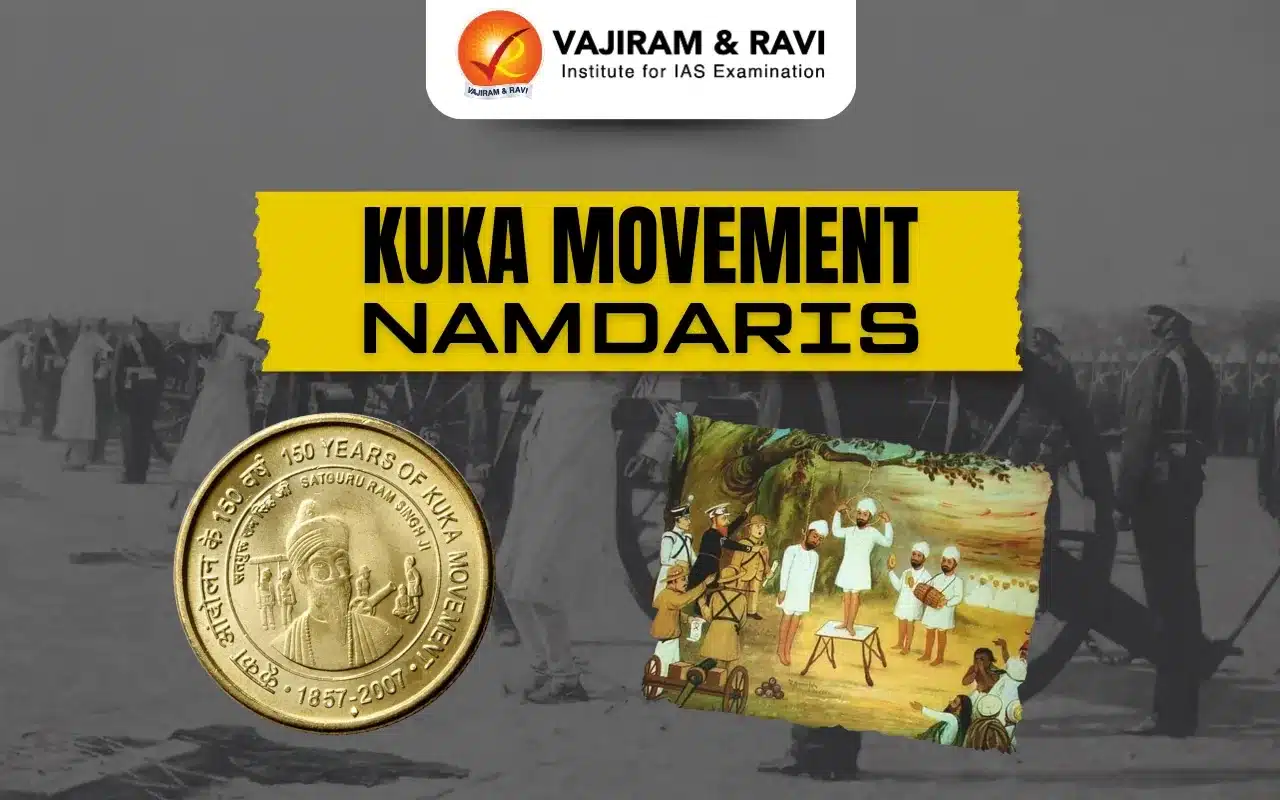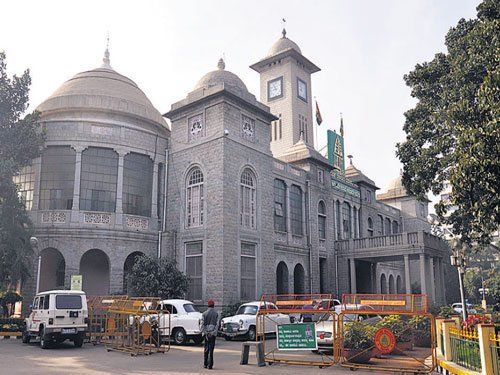The Kuka Movement, also known as the Namdhari Movement, was a significant social and religious uprising in Punjab during the mid-nineteenth century. The Kuka Movement emerged in response to British colonial rule and society's perceived moral degradation. Its goal was to restore Sikh practices to their original purity and resist British influence.
The Namdhari Movement (Kuka Movement) is regarded as one of the first organised revolts against British rule in India, combining religious zeal with a desire for social reform and political independence.
Kuka Movement Background
The Kuka Movement emerged in the mid-nineteenth century against the backdrop of British colonialism and the decline of Sikh sovereignty following the fall of the Sikh Empire in 1849. The British annexation of Punjab, followed by the imposition of foreign rule, caused widespread discontent among the Sikh population.
- Furthermore, there was growing concern about the decline of Sikh religious practices and the impact of Western culture. The movement arose in response to these developments, to revive Sikh traditions while opposing British dominance.
- The Namdhari movement was also known as the Kuka Movement. The Namdhari movement arose in the northwestern corner of the Sikh kingdom. The Namdhari Movement, of which the Kuka Movement was the most crucial phase, aimed at overthrowing British rule.
- The Namdharis were also known as "Kukas" due to their distinctive style of reciting the "Gurbani" (Sayings/Teachings of the Guru). This style used a high-pitched voice known as "kook" in Punjabi.
Kuka Movement Founder
Influenced by Baba Balak Singh and Bhagat Jawar Mal, who advocated for religious purity, Baba Ram Singh established the Namdhari sect at Bhaini Sahib on April 12, 1857, marking the start of the Kuka Movement.
Kuka Movement Objectives
After the British captured Punjab, the Kuka movement shifted from a religious purification campaign to a political one. The Kuka Movement sought to purify Sikhism by returning to its founding principles and eradicating perceived corrupt practices.
- Social Objectives: The core objectives of the Kuka Movement included the abolition of caste and other forms of discrimination against Sikhs, the prohibition of meat, alcohol, and drugs, the allowance of intermarriage, widow remarriage, and the encouragement of women to leave seclusion.
- Political Objectives: The Namdharis sought to depose the British and restore Sikh rule in Punjab; they advocated wearing hand-woven clothing and boycotting English laws, education, and products.
- Thus, Kukas propagated the concepts of Swadeshi and non-cooperation long before they became part of the Indian national movement in the early twentieth century.
Kuka Movement Course
The Kuka Movement gained traction by organising efforts to promote its goals. Baba Ram Singh and his followers conducted extensive tours of Punjab to preach their message, emphasising discipline and the importance of adhering to Sikh values.
- Baba Ram Singh urged his followers to boycott everything bearing the British Government's stamp. He appointed Governors and Deputy Governors to organise Kukas in various districts across Punjab.
- He also inspired young men by providing military training. They called for a boycott of British educational institutions and laws established by them.
- The Namdhari Movement reached its peak in 1872 when the violent conflict between the British and Namdharis broke out. The conflict began in 1871 and culminated in the Kuka raid on Malerkotla on January 15, 1872, which was met with terrible punishment. A large number of Kuka prisoners were killed with cannons, and their leader, Baba Ram Singh, was deported to Rangoon.
Kuka Movement Features
The Kuka Movement was characterised by its strong emphasis on religious, social, and economic reforms. The Kuka Movement had several distinctive features, including a distinctive appearance.
- Distinctive Appearance: Namdhari followers adopted a unique dress code, wearing white, hand-spun clothing and saffron turbans. The movement advocated vegetarianism, a simple lifestyle and rejection of ostentation.
- Social Justice: The Kuka Movement also promoted social justice, particularly by advocating for the abolition of the Caste System and improving the status of women.
- It also advocated for intermarriages, widow remarriage, and encouraging women to step out of seclusion.
- Religious Reform: The Namdhari movement was deeply rooted in Sikh religious traditions, emphasising a return to the purest form of Sikhism as practised by Guru Gobind Singh.
- Self-Reliance: The Kuka Movement encouraged self-reliance, urging followers to boycott British goods and services and to support indigenous crafts and industries.
Kuka Movement Significance
The Kuka Movement is historically significant as one of India's early anti-colonial uprisings. It was instrumental in reviving and strengthening Sikh identity, emphasising a return to religious purity and traditional values.
- Inspiration for Future Social Reforms: The Kuka Movement's emphasis on social reform, particularly in challenging the caste system and advocating for women's rights, paved the way for future social justice movements in India.
- Contribution to Freedom Struggle: The Kuka Movement promoted self-reliance by encouraging a boycott of British goods, foreshadowing the more significant Swadeshi movement, which became a crucial strategy in India's independence struggle.
- The Namdharis began publishing the newspaper 'Satyug' in 1920, followed by the daily 'Kuka' in 1922. Kukas also joined the non-cooperation movement.
- Women's Empowerment: The Kuka Movement also championed women's rights, promoting gender equality at a time when women's roles were confined mainly to domestic spheres.
- Political Awareness: The Namdharis raised political consciousness among Punjabis and fostered a spirit of resistance against colonial rule. It made the people aware of their serfdom and bondage and instilled feelings of self-respect and sacrifice for the country.
Last updated on December, 2025
→ Check out the latest UPSC Syllabus 2026 here.
→ Join Vajiram & Ravi’s Interview Guidance Programme for expert help to crack your final UPSC stage.
→ UPSC Mains Result 2025 is now out.
→ UPSC Notification 2026 is scheduled to be released on January 14, 2026.
→ UPSC Calendar 2026 is released on 15th May, 2025.
→ The UPSC Vacancy 2025 were released 1129, out of which 979 were for UPSC CSE and remaining 150 are for UPSC IFoS.
→ UPSC Prelims 2026 will be conducted on 24th May, 2026 & UPSC Mains 2026 will be conducted on 21st August 2026.
→ The UPSC Selection Process is of 3 stages-Prelims, Mains and Interview.
→ UPSC Result 2024 is released with latest UPSC Marksheet 2024. Check Now!
→ UPSC Prelims Result 2025 is out now for the CSE held on 25 May 2025.
→ UPSC Toppers List 2024 is released now. Shakti Dubey is UPSC AIR 1 2024 Topper.
→ UPSC Prelims Question Paper 2025 and Unofficial Prelims Answer Key 2025 are available now.
→ UPSC Mains Question Paper 2025 is out for Essay, GS 1, 2, 3 & GS 4.
→ UPSC Mains Indian Language Question Paper 2025 is now out.
→ UPSC Mains Optional Question Paper 2025 is now out.
→ Also check Best IAS Coaching in Delhi
Kuka Movement FAQs
Q1. Who started the KUKA movement?+
Q2. Which animal was worshipped in the Kuka movement?+
Q3. Who was the Viceroy of India during the Kuka movement?+
Q4. What is a Namdhari in Sikhism?+
Q5. Where is the headquarters of the Kuka movement?+
Tags: kuka movement quest

















